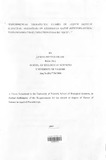| dc.description.abstract | The first line therapy for all types of leishmaniases requires potentially toxic and painful multiple
injections of pentavalent antimonies and aromatic diamidines. A major limitation of these drugs
is that they are very expensive and cause severe side effects due to their high toxicity, hence not
accessible to the majority poor populations. Recently, the emergence of antimony-resistant
parasites has compelled the search for new antileishmanial agents. There is therefore an urgent
need to develop cheaper, affordable and effective indigenous formulations against Leishmania
Ross parasites. Several new antileishmanial compounds are under development, but a drug with
the capacity to completely cure these infections has not been discovered. Although most active
drugs against infectious agents are derived from medicinal plants, scientific evaluation of the
medicinal properties of plants remains grossly understudied.
Development of anti- parasite compounds could emerge from screening of natural libraries of
plant compounds with recognized anti- parasitic activities. Among these, is Allium sativum (L.)
(Liliaceae: Alliaceae) which has been described as having immunomodulatory activity and
therapeutic properties. This study has investigated the therapeutic effect of extracts from A.
sativum for activity on Leishmania major Yarkimaff and Schokor amastigotes in vivo and
promastigotes in vitro. Serial dilutions of the crude extract at 250pg/ml, 500pg/ml and lOOOpg/ml
were assayed for their activity against L. major in cell free cultures. The analysis program Probit
was used to determine 50% inhibitory concentration ( IC50j.A.sativum crude extract was found to
have an IC50 of 2.216 mg/ml. A. sativum extract was then examined for efficacy in treatment of L. major-infected BALB/c mice (Mus musculus L.).
The susceptible BALB/c mice were subcutaneously inoculated with L. major parasites and disease progression monitored for one month. The infected mice were then treated with different formulations of extracts from A. sativum.The experimental groups either received topical application of A.sativum ointment, oral or intraperitoneal injection with extract formulation for five weeks post infection.The control groups either were treated with antileishmanial drug Pentostam® as a positive control or olive oil and Phosphate buffered saline (PBS) as negative control.
xiv
Parasite load/ numbers were assayed before and after treatment using Leishman Donovan Assay (LDA) and spleen impression smears (LDU) on termination. The disease progression was assessed by measuring footpad lesion sizes weekly with venier caliper for both infected and uninfected footpads of mice.Mice were significantly protected from L. major, displaying decreases in lesion size and parasite burden, particularly those on topical treatment. In contrast, mice that were treated either with olive oil or PBS showed a marked increase in disease progression leading to increased lesion sizes. The ointment from extract of A.sativum was found to be more effective than the positive control Pentostam® . Males had larger lesions than females but lesions did not ulcerate in both cases. The marked clearance of Leishmania parasites from a susceptible strain of mice suggests that crude extracts of A. sativum represent a potentially useful formulation for treatment of cutaneous leishmaniasis. | en_US |



